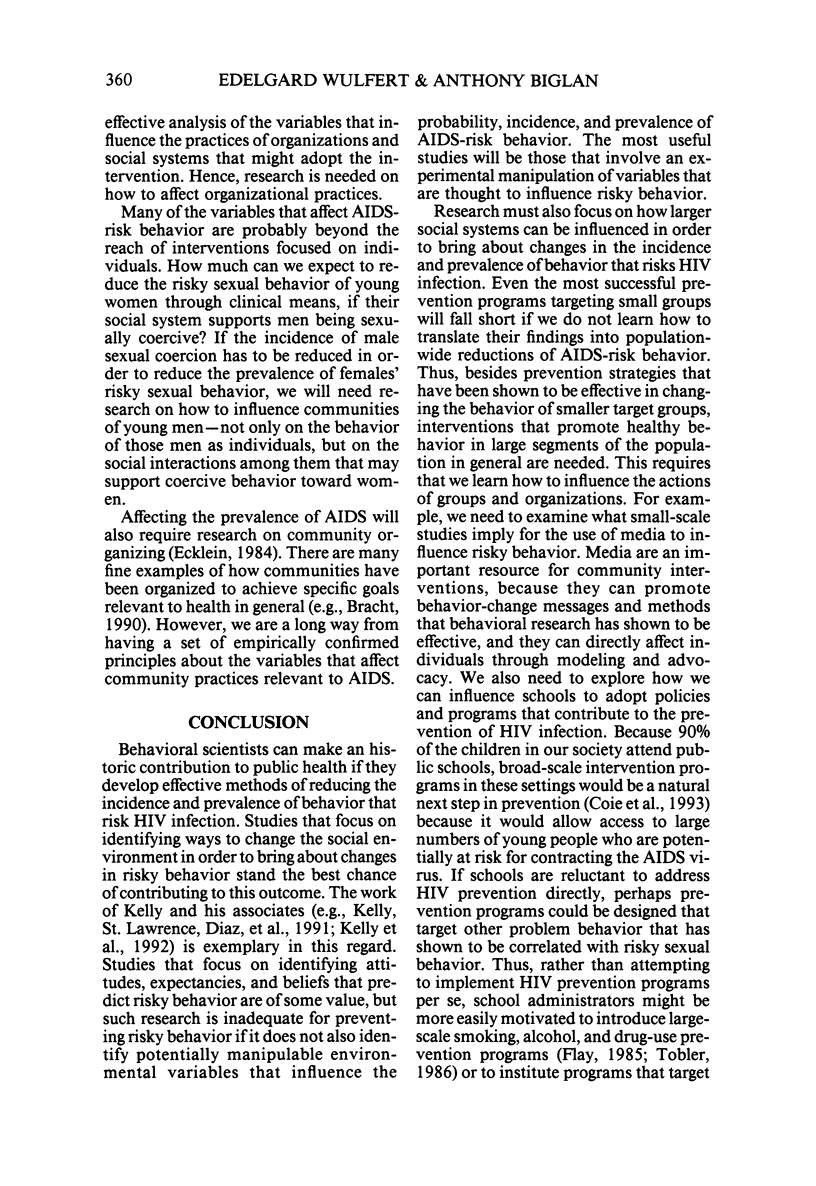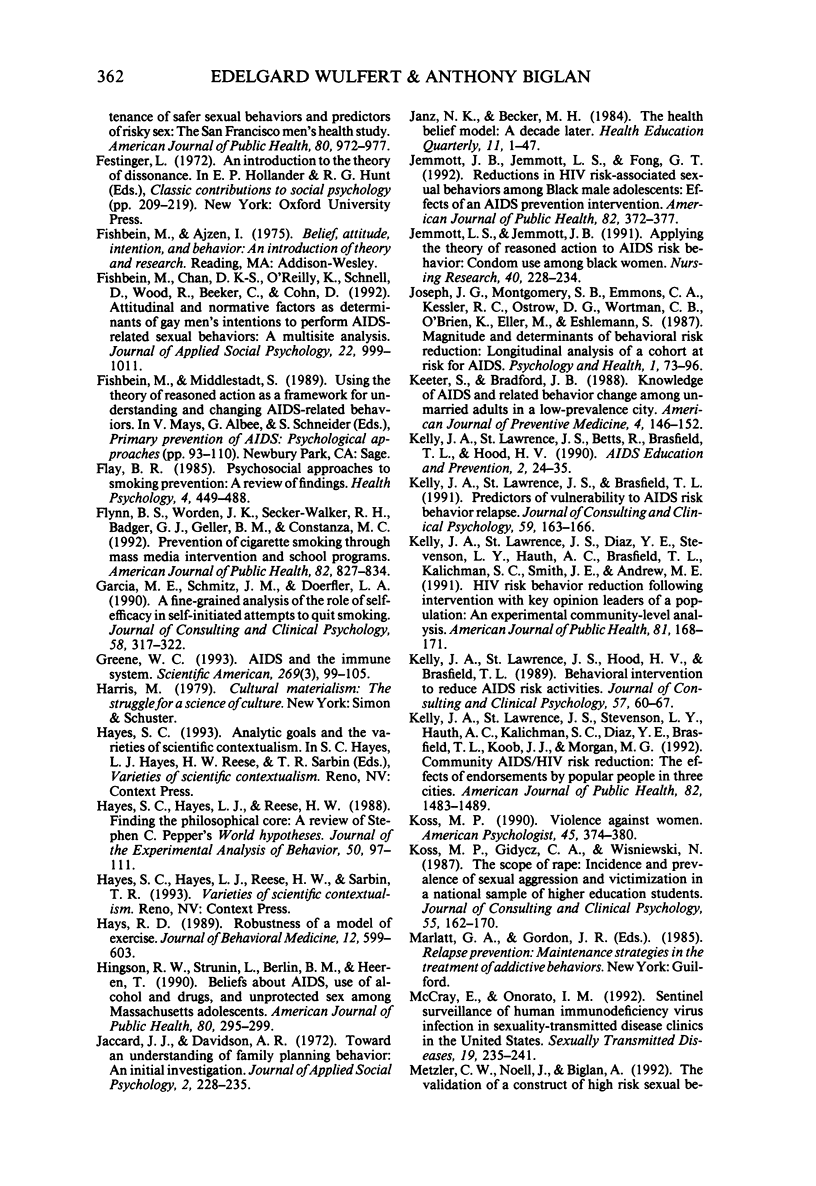Abstract
The acquired immune deficiency syndrome (AIDS) is a disease that is transmitted almost entirely through behavioral factors. In the absence of a cure or vaccine, the modification of AIDS-risk behavior presents a unique challenge to behavioral scientists and should be taken as a clear imperative by behavior analysts. This paper discusses the currently dominant social-cognitive theories (the health belief model, the theory of reasoned action, and self-efficacy theory) that have been widely used to predict and understand AIDS-risk behavior. Although these theories have generated a voluminous literature on the cognitive, attitudinal, and demographic correlates of AIDS-risk behavior, they have not resulted in specific intervention strategies to influence risky behavior, most likely because they fail to specify manipulable variables. As an alternative to social-cognitive theories, this paper evaluates the usefulness of a behavior-analytic approach to stem the spread of HIV infection. It examines some of the philosophical differences underlying cognitive and behavioral approaches that are embedded in mechanistic versus functional contextualistic principles. It explores the theoretical and practical implications of adopting either predicting and explaining behavior or predicting and influencing behavior as the goals of science. To illustrate the value of adopting the goal of prediction and influence, behavior-analytic research on the social context of risky sexual behavior in adolescents is described. The paper argues that in order to alter the future course of the AIDS epidemic, the behavioral sciences must move beyond describing cognitive and attitudinal correlates of risky behavior and focus on the social context of the behavior of individuals. In addition, population-wide changes in AIDS-risk behavior can be accomplished only if research focuses on how to influence larger social systems, including the media, school systems, and community organizations.
Keywords: acquired immune deficiency syndrome (AIDS), functional contextualism, health belief model, self-efficacy theory, theory of reasoned action
Full text
PDF










Selected References
These references are in PubMed. This may not be the complete list of references from this article.
- Brown L. K., DiClemente R. J., Reynolds L. A. HIV prevention for adolescents: utility of the Health Belief Model. AIDS Educ Prev. 1991 Spring;3(1):50–59. [PubMed] [Google Scholar]
- Carmel S. The Health Belief Model in the research of AIDS-related preventive behavior. Public Health Rev. 1990;18(1):73–85. [PubMed] [Google Scholar]
- Catania J. A., Coates T. J., Stall R., Turner H., Peterson J., Hearst N., Dolcini M. M., Hudes E., Gagnon J., Wiley J. Prevalence of AIDS-related risk factors and condom use in the United States. Science. 1992 Nov 13;258(5085):1101–1106. doi: 10.1126/science.1439818. [DOI] [PubMed] [Google Scholar]
- Centers for Disease Control (CDC) Acquired immunodeficiency syndrome (AIDS) update--United States. MMWR Morb Mortal Wkly Rep. 1983 Jun 24;32(24):309–311. [PubMed] [Google Scholar]
- Centers for Disease Control (CDC) Kaposi's sarcoma and Pneumocystis pneumonia among homosexual men--New York City and California. MMWR Morb Mortal Wkly Rep. 1981 Jul 3;30(25):305–308. [PubMed] [Google Scholar]
- Coie J. D., Watt N. F., West S. G., Hawkins J. D., Asarnow J. R., Markman H. J., Ramey S. L., Shure M. B., Long B. The science of prevention. A conceptual framework and some directions for a national research program. Am Psychol. 1993 Oct;48(10):1013–1022. doi: 10.1037//0003-066x.48.10.1013. [DOI] [PubMed] [Google Scholar]
- Des Jarlais D. C., Friedman S. R. The psychology of preventing AIDS among intravenous drug users. A social learning conceptualization. Am Psychol. 1988 Nov;43(11):865–870. doi: 10.1037/0003-066X.43.11.865. [DOI] [PubMed] [Google Scholar]
- Dishion T. J., Patterson G. R., Reid J. R. Parent and peer factors associated with drug sampling in early adolescence: implications for treatment. NIDA Res Monogr. 1988;77:69–93. [PubMed] [Google Scholar]
- Ekstrand M. L., Coates T. J. Maintenance of safer sexual behaviors and predictors of risky sex: the San Francisco Men's Health Study. Am J Public Health. 1990 Aug;80(8):973–977. doi: 10.2105/ajph.80.8.973. [DOI] [PMC free article] [PubMed] [Google Scholar]
- Flay B. R. Psychosocial approaches to smoking prevention: a review of findings. Health Psychol. 1985;4(5):449–488. doi: 10.1037//0278-6133.4.5.449. [DOI] [PubMed] [Google Scholar]
- Flynn B. S., Worden J. K., Secker-Walker R. H., Badger G. J., Geller B. M., Costanza M. C. Prevention of cigarette smoking through mass media intervention and school programs. Am J Public Health. 1992 Jun;82(6):827–834. doi: 10.2105/ajph.82.6.827. [DOI] [PMC free article] [PubMed] [Google Scholar]
- Garcia M. E., Schmitz J. M., Doerfler L. A. A fine-grained analysis of the role of self-efficacy in self-initiated attempts to quit smoking. J Consult Clin Psychol. 1990 Jun;58(3):317–322. doi: 10.1037//0022-006x.58.3.317. [DOI] [PubMed] [Google Scholar]
- Greene W. C. AIDS and the immune system. Sci Am. 1993 Sep;269(3):98–105. doi: 10.1038/scientificamerican0993-98. [DOI] [PubMed] [Google Scholar]
- Hayes S. C., Hayes L. J., Reese H. W. Finding the philosophical core: A review of Stephen C. Pepper's World Hypotheses: A Study in Evidence. J Exp Anal Behav. 1988 Jul;50(1):97–111. doi: 10.1901/jeab.1988.50-97. [DOI] [PMC free article] [PubMed] [Google Scholar]
- Hays R. D. Robustness of a model of exercise. J Behav Med. 1989 Dec;12(6):599–603. doi: 10.1007/BF00844828. [DOI] [PubMed] [Google Scholar]
- Hingson R. W., Strunin L., Berlin B. M., Heeren T. Beliefs about AIDS, use of alcohol and drugs, and unprotected sex among Massachusetts adolescents. Am J Public Health. 1990 Mar;80(3):295–299. doi: 10.2105/ajph.80.3.295. [DOI] [PMC free article] [PubMed] [Google Scholar]
- Janz N. K., Becker M. H. The Health Belief Model: a decade later. Health Educ Q. 1984 Spring;11(1):1–47. doi: 10.1177/109019818401100101. [DOI] [PubMed] [Google Scholar]
- Jemmott J. B., 3rd, Jemmott L. S., Fong G. T. Reductions in HIV risk-associated sexual behaviors among black male adolescents: effects of an AIDS prevention intervention. Am J Public Health. 1992 Mar;82(3):372–377. doi: 10.2105/ajph.82.3.372. [DOI] [PMC free article] [PubMed] [Google Scholar]
- Jemmott L. S., Jemmott J. B., 3rd Applying the theory of reasoned action to AIDS risk behavior: condom use among black women. Nurs Res. 1991 Jul-Aug;40(4):228–234. [PubMed] [Google Scholar]
- Keeter S., Bradford J. B. Knowledge of AIDS and related behavior change among unmarried adults in a low-prevalence city. Am J Prev Med. 1988 May-Jun;4(3):146–152. [PubMed] [Google Scholar]
- Kelly J. A., St Lawrence J. S., Betts R., Brasfield T. L., Hood H. V. A skills-training group intervention model to assist persons in reducing risk behaviors for HIV infection. AIDS Educ Prev. 1990 Spring;2(1):24–35. [PubMed] [Google Scholar]
- Kelly J. A., St Lawrence J. S., Brasfield T. L. Predictors of vulnerability to AIDS risk behavior relapse. J Consult Clin Psychol. 1991 Feb;59(1):163–166. doi: 10.1037//0022-006x.59.1.163. [DOI] [PubMed] [Google Scholar]
- Kelly J. A., St Lawrence J. S., Diaz Y. E., Stevenson L. Y., Hauth A. C., Brasfield T. L., Kalichman S. C., Smith J. E., Andrew M. E. HIV risk behavior reduction following intervention with key opinion leaders of population: an experimental analysis. Am J Public Health. 1991 Feb;81(2):168–171. doi: 10.2105/ajph.81.2.168. [DOI] [PMC free article] [PubMed] [Google Scholar]
- Kelly J. A., St Lawrence J. S., Hood H. V., Brasfield T. L. Behavioral intervention to reduce AIDS risk activities. J Consult Clin Psychol. 1989 Feb;57(1):60–67. doi: 10.1037//0022-006x.57.1.60. [DOI] [PubMed] [Google Scholar]
- Kelly J. A., St Lawrence J. S., Stevenson L. Y., Hauth A. C., Kalichman S. C., Diaz Y. E., Brasfield T. L., Koob J. J., Morgan M. G. Community AIDS/HIV risk reduction: the effects of endorsements by popular people in three cities. Am J Public Health. 1992 Nov;82(11):1483–1489. doi: 10.2105/ajph.82.11.1483. [DOI] [PMC free article] [PubMed] [Google Scholar]
- Koss M. P., Gidycz C. A., Wisniewski N. The scope of rape: incidence and prevalence of sexual aggression and victimization in a national sample of higher education students. J Consult Clin Psychol. 1987 Apr;55(2):162–170. doi: 10.1037//0022-006x.55.2.162. [DOI] [PubMed] [Google Scholar]
- Koss M. P. The women's mental health research agenda. Violence against women. Am Psychol. 1990 Mar;45(3):374–380. doi: 10.1037//0003-066x.45.3.374. [DOI] [PubMed] [Google Scholar]
- McCray E., Onorato I. M. Sentinel surveillance of human immunodeficiency virus infection in sexually transmitted disease clinics in the United States. Sex Transm Dis. 1992 Jul-Aug;19(4):235–241. doi: 10.1097/00007435-199207000-00010. [DOI] [PubMed] [Google Scholar]
- Montgomery S. B., Joseph J. G., Becker M. H., Ostrow D. G., Kessler R. C., Kirscht J. P. The Health Belief Model in understanding compliance with preventive recommendations for AIDS: how useful? AIDS Educ Prev. 1989 Winter;1(4):303–323. [PubMed] [Google Scholar]
- O'Leary A., Goodhart F., Jemmott L. S., Boccher-Lattimore D. Predictors of safer sex on the college campus: a social cognitive theory analysis. J Am Coll Health. 1992 May;40(6):254–263. doi: 10.1080/07448481.1992.9936290. [DOI] [PubMed] [Google Scholar]
- Perry C. L., Klepp K. I., Shultz J. M. Primary prevention of cardiovascular disease: communitywide strategies for youth. J Consult Clin Psychol. 1988 Jun;56(3):358–364. doi: 10.1037//0022-006x.56.3.358. [DOI] [PubMed] [Google Scholar]
- Rotheram-Borus M. J., Koopman C., Haignere C., Davies M. Reducing HIV sexual risk behaviors among runaway adolescents. JAMA. 1991 Sep 4;266(9):1237–1241. [PubMed] [Google Scholar]
- Siegel K., Gibson W. C. Barriers to the modification of sexual behavior among heterosexuals at risk for acquired immunodeficiency syndrome. N Y State J Med. 1988 Feb;88(2):66–70. [PubMed] [Google Scholar]
- Sonnabend J., Witkin S. S., Purtilo D. T. Acquired immunodeficiency syndrome, opportunistic infections, and malignancies in male homosexuals. A hypothesis of etiologic factors in pathogenesis. JAMA. 1983 May 6;249(17):2370–2374. [PubMed] [Google Scholar]
- Strecher V. J., DeVellis B. M., Becker M. H., Rosenstock I. M. The role of self-efficacy in achieving health behavior change. Health Educ Q. 1986 Spring;13(1):73–92. doi: 10.1177/109019818601300108. [DOI] [PubMed] [Google Scholar]
- Valdiserri R. O., Lyter D., Leviton L. C., Callahan C. M., Kingsley L. A., Rinaldo C. R. Variables influencing condom use in a cohort of gay and bisexual men. Am J Public Health. 1988 Jul;78(7):801–805. doi: 10.2105/ajph.78.7.801. [DOI] [PMC free article] [PubMed] [Google Scholar]
- Wulfert E., Wan C. K. Condom use: a self-efficacy model. Health Psychol. 1993 Sep;12(5):346–353. doi: 10.1037//0278-6133.12.5.346. [DOI] [PubMed] [Google Scholar]


